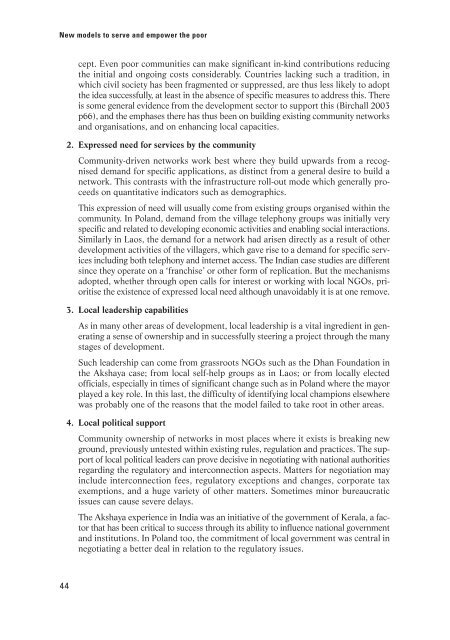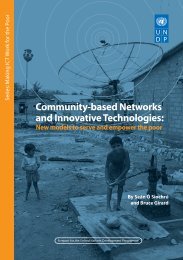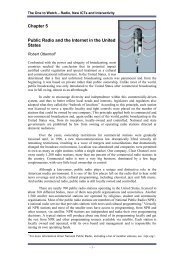report - Community-based Networks and Innovative Technologies ...
report - Community-based Networks and Innovative Technologies ...
report - Community-based Networks and Innovative Technologies ...
Create successful ePaper yourself
Turn your PDF publications into a flip-book with our unique Google optimized e-Paper software.
New models to serve <strong>and</strong> empower the poor<br />
cept. Even poor communities can make significant in-kind contributions reducing<br />
the initial <strong>and</strong> ongoing costs considerably. Countries lacking such a tradition, in<br />
which civil society has been fragmented or suppressed, are thus less likely to adopt<br />
the idea successfully, at least in the absence of specific measures to address this. There<br />
is some general evidence from the development sector to support this (Birchall 2003<br />
p66), <strong>and</strong> the emphases there has thus been on building existing community networks<br />
<strong>and</strong> organisations, <strong>and</strong> on enhancing local capacities.<br />
2. Expressed need for services by the community<br />
<strong>Community</strong>-driven networks work best where they build upwards from a recognised<br />
dem<strong>and</strong> for specific applications, as distinct from a general desire to build a<br />
network. This contrasts with the infrastructure roll-out mode which generally proceeds<br />
on quantitative indicators such as demographics.<br />
This expression of need will usually come from existing groups organised within the<br />
community. In Pol<strong>and</strong>, dem<strong>and</strong> from the village telephony groups was initially very<br />
specific <strong>and</strong> related to developing economic activities <strong>and</strong> enabling social interactions.<br />
Similarly in Laos, the dem<strong>and</strong> for a network had arisen directly as a result of other<br />
development activities of the villagers, which gave rise to a dem<strong>and</strong> for specific services<br />
including both telephony <strong>and</strong> internet access. The Indian case studies are different<br />
since they operate on a ‘franchise’ or other form of replication. But the mechanisms<br />
adopted, whether through open calls for interest or working with local NGOs, prioritise<br />
the existence of expressed local need although unavoidably it is at one remove.<br />
3. Local leadership capabilities<br />
As in many other areas of development, local leadership is a vital ingredient in generating<br />
a sense of ownership <strong>and</strong> in successfully steering a project through the many<br />
stages of development.<br />
Such leadership can come from grassroots NGOs such as the Dhan Foundation in<br />
the Akshaya case; from local self-help groups as in Laos; or from locally elected<br />
officials, especially in times of significant change such as in Pol<strong>and</strong> where the mayor<br />
played a key role. In this last, the difficulty of identifying local champions elsewhere<br />
was probably one of the reasons that the model failed to take root in other areas.<br />
4. Local political support<br />
<strong>Community</strong> ownership of networks in most places where it exists is breaking new<br />
ground, previously untested within existing rules, regulation <strong>and</strong> practices. The support<br />
of local political leaders can prove decisive in negotiating with national authorities<br />
regarding the regulatory <strong>and</strong> interconnection aspects. Matters for negotiation may<br />
include interconnection fees, regulatory exceptions <strong>and</strong> changes, corporate tax<br />
exemptions, <strong>and</strong> a huge variety of other matters. Sometimes minor bureaucratic<br />
issues can cause severe delays.<br />
The Akshaya experience in India was an initiative of the government of Kerala, a factor<br />
that has been critical to success through its ability to influence national government<br />
<strong>and</strong> institutions. In Pol<strong>and</strong> too, the commitment of local government was central in<br />
negotiating a better deal in relation to the regulatory issues.<br />
44
















